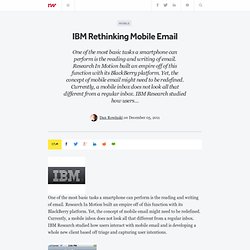

Miami Dolphins, IBM Team Up for Stadium of the Future. Text messages that tell fans when their usual parking lot is full and where to park instead.

Automated alerts that avoid dangerous overcrowding by directing masses of spectators to specific gates to enter and exit. Inclement weather warnings that prepare people in the stands for a storm before it hits. All that and more will soon become real at south Florida's Sun Life Stadium, thanks to a high-tech partnership the Miami Dolphins and IBM announced Tuesday. The agreement incorporates IBM's cutting-edge analytics technology into the Dolphins' home stadium, which also hosts many concerts and other events. It will make Sun Life Stadium the most advanced venue of its kind in North America, say IBM and Dolphins officials. With 75,00 seats, 24,000 parking spots, 1.5 million square feet of space and the world's largest point-of-sale vending system under one roof, Sun Life Stadium functions almost as its own little city when the Dolphins play or a famous performer comes to town.
IBM Explains How Mind-Reading Machines Will Change Our Lives. In five years, we'll simply be able to think something, and a computer will respond.

That's the vision from IBM, which just published its "5 in 5" forecast, which attempts to predict five technologies that have the potential to significantly change our lives in the next five years. One of the more surprising candidates: machines that will read our thoughts. Well, not exactly, IBM Senior Inventor Kevin Brown told Mashable. The idea is a little more down-to-earth — and less scary — than the science-fiction scenarios of mind-reading robots that the description evokes. IBM's vision is this: a person wears a headset (shown above, worn by Brown) that can detect general electrical signals from the brain, and sends them to a computer. "One of the common misconceptions is that this headset is reading your thoughts," says Brown. The technology behind the idea has existed for a while. IBM and 3M Discover the Secret to Making Processors 1,000 Times Faster. If you want to make processors 1,000 times faster, you're going to need some serious technology, right?

That would be the conventional wisdom. But 3M and IBM have unlocked a secret low-tech shortcut. The companies found a much simpler way to hit that elusive goal — not by creating some spectacular new circuitry or using exotic quantum mechanics, but with the invention of a new variety of a mundane substance: glue. This is not just any glue. It's an adhesive that dissipates heat so efficiently that layer upon layer of chips can be stacked on top of each other into silicon "towers" up to 100 layers high, glued together with this special adhesive that keeps things cool. With IBM supplying its microprocessor and silicon expertise and 3M contributing its super-cool adhesive, the two companies aim to stack together processors, memory chips and networks into monster "skyscrapers" of silicon they say will be 1,000 times faster than today's fastest processor.
[via IBM and DVICE] IBM Rethinking Mobile Email. One of the most basic tasks a smartphone can perform is the reading and writing of email.

Research In Motion built an empire off of this function with its BlackBerry platform. Yet, the concept of mobile email might need to be redefined. Currently, a mobile inbox does not look all that different from a regular inbox. IBM Research studied how users interact with mobile email and is developing a whole new client based off triage and capturing user intentions. Think about how you interact with mobile email on a message-by-message basis. This is where IBM Research wants to help by recreating the user interface for mobile email. Once a user has determined new messages, the untriaged view of the inbox looks a lot like a normal mobile email client.
It is then time to capture the intention of what users want to do with the email. Users can also assign a specification action such as call, print, read, reply, save, schedule, send and visit. The study was done by IBM Research guru Jeff Pierce. IBM's Andy Piper (Part 3): The Taxonomy of All Things. Every addressable resource on the Web has what W3C now calls a Uniform Resource Identifier (not URL, but URI).

Anything that can provide information to a client in response to a request, may be addressed using this syntax. It takes care the what, where, and how. How will the Internet of Things make everything addressable by every other thing, as explicitly promised by IBM - which is proposing one candidate for an IoT protocol in the form of MQTT? In the concluding part of ReadWriteWeb's discussion with MQTT engineer and WebSphere MQ community lead Andy Piper (continued from part 2 last Tuesday), we learned how IBM is actually now in its second decade of working out a kind of "thing taxonomy" - a way for its messaging queue protocol to resolve the where and how of contacting a small, MQTT-enabled device by first sorting through what it is. Directory assistance.